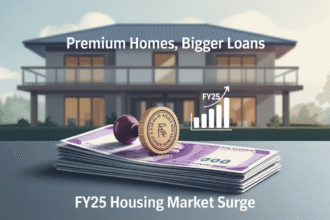India’s housing finance sector witnessed a notable surge in home loan disbursals during the financial year 2024–25 (FY25), reflecting strong demand for residential properties—especially in the premium segment. A report by Urban Money, the fintech platform of Square Yards, highlights a 10% increase in loan volumes and a 15% rise in total disbursal value across key cities, compared to the previous fiscal year.
This growth underscores shifting buyer preferences, increased urban migration, and evolving financial behavior among Indian borrowers.
Premium Housing Demand Drives Larger Loans
One of the most significant trends was the growth in premium housing finance. Home loans exceeding ₹1 crore constituted 21% of total disbursals, marking a strong uptick in demand for high-value residential properties. This shift indicates increased purchasing power and a willingness among urban buyers to invest in larger, better-located homes.
Increase in Average Loan Size
The average home loan size across major cities reached ₹74 lakh, up from the previous year by 5%. Among metropolitan areas, Mumbai led with an average loan size of ₹99 lakh, followed by Gurugram at ₹88 lakh. These figures align with rising property prices in premium localities and a preference for lifestyle-centric housing.
Greater Participation by Women Borrowers
The report also points to a rising trend in women-led borrowing. In FY25, 20% of home loan borrowers were women. Notably, the average loan size among women increased by 13% year-on-year to ₹70 lakh, significantly higher than the 3% growth in average loan size among men. This suggests growing financial independence, ownership aspirations, and improved access to credit for women.
Property-Linked Loans Remain Dominant
Combined, home loans and loans against property made up 63% of all loan disbursals in FY25. This figure underscores the centrality of real estate in secured lending portfolios and the continued preference for property as a wealth-creation asset.
Long-Term Momentum Reflected in Registrations
Residential property registrations in key Indian cities climbed steadily over the years—from 3.07 lakh units in FY19 to 5.44 lakh units in FY25, representing a 77% increase. This trend reaffirms the structural growth of India’s housing sector, supported by increased transparency, digital processes, and regulatory reforms.
Conclusion
The FY25 data paints a clear picture of resilience and transformation in India’s housing market. From rising ticket sizes to increased participation from women, and from the dominance of property-linked lending to the surge in registrations, the sector reflects both growing aspirations and confidence among urban homebuyers.
As the economy stabilizes and urbanization accelerates, India’s housing finance industry is likely to witness sustained momentum—driven by demographic shifts, rising incomes, and evolving lifestyle needs.







